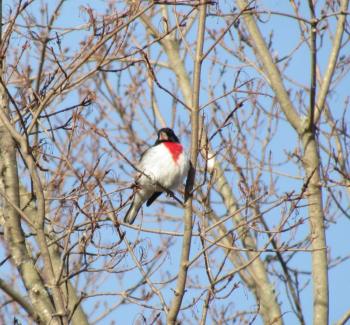A Sweet and Syrupy Sign of Spring
We had the pleasure this morning of looking out the kitchen window to see a striking male rose-breasted grosbeak sunning himself near the top of a still-leafless maple tree. The bird’s bright red breast spot contrasted markedly with its otherwise bold black-and-white plumage, demonstrating again to us why people call bird center hotlines to report bleeding birds when rose-breasted grosbeaks arrive each spring! One other observation about the identification of the rose-breasted grosbeak: over the years, we have talked with many people who confuse the pine grosbeak with the rose-breasted grosbeak. The two do not look similar in any way, but the male pine grosbeak is actually what many people would describe as a rich, rosy color on the head and breast. Without reference to illustrations of the two species, people who have seen a grosbeak that is rosy-colored on the breast assume that such a bird would logically be named the “rose-breasted” grosbeak. Pine grosbeaks are usually only seen in winter here in Maine while rose-breasted grosbeaks are normally only found in the warmer months.
It is a bit early for rose-breasted grosbeaks, although a few had been seen and photographed around the state (and even up into Nova Scotia) as early as last week, according to reports submitted to eBird. Interestingly, eBird also shows that people are still seeing rose-breasted grosbeaks far down into their South and Central American wintering range and in migration across the southern U.S., including in Florida (we didn’t see any last week when we were there on vacation).
Rose-breasted grosbeaks are showing a long-term decline across their breeding range which encompasses the northern half of the eastern U.S. and southeastern Canada and as far north as the southern part of the Northwest Territories in western Canada. They have also shown a long-term decline in Maine since the late 1960’s. The reasons for the declines are unknown as relatively little research has been carried out on the factors impacting its reproduction and survival.
Rose-breasted grosbeaks seem to be a bird that is most obvious upon their first arrival. That’s partly because, in the spring, they are keen visitors to bird feeders, enjoying sunflower seeds and sometimes dipping into oranges or offerings of jelly. Having just arrived from a winter spent in the tropics, they are still (like migrant Baltimore orioles) probably accustomed to probing into flowers and delving into juicy sweet fruits, which explains why the orange halves and jelly is so alluring to them. As the season progresses, they leave the feeders to establish territories and switch to largely an insect diet, at least until the late summer when berries begin to ripen.
If you learn the song of the rose-breasted grosbeak, you will notice them in many places from late May through mid to late June. After that, they stop singing for the most part and are a bit harder to spot. That is, unless you also know their distinctive call, which sounds like a sneaker stopping quickly on a gym floor. Whenever we watch a basketball game, we have to turn off the rose-breasted grosbeak call detector in our minds because of the many sneaker squeaks!
The song of the rose-breasted grosbeak is similar to the American robin in that it is a series of short, sweet phrases but often sung more quickly and fluidly, without pauses between phrases. The grosbeak song is often said to be like a sweet, syrupy robin song. When you hear the songs of the two species together, this description makes perfect sense, even though it is hard to put your finger on exactly what qualities make a song seem “sweet” and “syrupy.” Take our word for it and listen when the rose-breasted grosbeaks arrive in your yard!
Jeffrey V. Wells, Ph.D., is a Fellow of the Cornell Lab of Ornithology. Dr. Wells is one of the nation's leading bird experts and conservation biologists and author of “Birder’s Conservation Handbook”. His grandfather, the late John Chase, was a columnist for the Boothbay Register for many years. Allison Childs Wells, formerly of the Cornell Lab of Ornithology, is a senior director at the Natural Resources Council of Maine, a nonprofit membership organization working statewide to protect the nature of Maine. Both are widely published natural history writers and are the authors of the book, “Maine’s Favorite Birds” and the newly published “Birds of Aruba, Bonaire, and Curaçao” from Cornell Press.






























